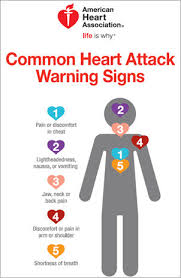Heart attack
A heart attack occurs when an artery that sends blood and oxygen to the heart is blocked. Fatty, cholesterol-containing deposits build up over time, forming plaques in the heart's arteries. If a plaque ruptures, a blood clot can form. The clot can block arteries, causing a heart attack. During a heart attack, a lack of blood flow causes the tissue in the heart muscle to die.
Symptoms of a heart attack vary. Some people have mild symptoms. Others have severe symptoms. Some people have no symptoms.
Common heart attack symptoms include:- Chest pain that may feel like pressure, tightness, pain, squeezing or aching
- Pain or discomfort that spreads to the shoulder, arm, back, neck, jaw, teeth or sometimes the upper belly
- Cold sweat
- Fatigue
- Heartburn or indigestion
- Lightheadedness or sudden dizziness
- Nausea
- Shortness of breath
- Discomfort, squeezing, pressure, or fullness in the middle of the chest: This may last for a few minutes, or it could start to feel better and then return.
- Discomfort elsewhere: Early heart attack symptoms in other parts of the body can affect one or both arms, the back, neck, jaw, or stomach.
- Breathlessness: This might happen before a person feels discomfort in their chest, but it often occurs alongside the chest discomfort.
- Other early symptoms: A person might break out in cold sweats, feel nauseous, or experience lightheadedness early in a heart attack.
- a feeling of pressure, tightness, pain, squeezing, or aching in the chest
- pain that spreads to the arms, neck, jaw, or back
- a feeling of crushing or heaviness in the chest
- a feeling similar to heartburn or indigestion
- nausea and sometimes vomiting
- feeling clammy and sweaty
- shortness of breath
- feeling lightheaded or dizzy
- in some cases, anxiety that can feel similar to a panic attack
- coughing or wheezing, if fluid builds up in the lungs
Coronary artery disease (CAD) is the most common disease for heart related people.
The hearts of people with CAD do not receive enough oxygen-rich blood, as the coronary artery, which leads to the heart, becomes narrower. This is due to a buildup of a waxy plaque on the artery walls that worsens over several years.
When plaque breaks off, it can lead to a blood clot that completely blocks blood flow to the heart, meaning the heart muscles start to die without prompt treatment.
- Percutaneous coronary intervention: A cardiologist threads a balloon-tipped catheter to open the blockage and places a stent to keep the blood vessel open.
- Bypass surgery: A cardiac surgeon uses a graft to bypass areas of blockage.
- Heart transplant: A person may have a heart transplant for severe heart failure due to coronary disease when a surgeon cannot
CPR
Do manual chest compressions:
- Lock your fingers together and place the base of your hands in the center of the chest.
- Position your shoulders over your hands, lock your elbows, and press hard and fast, at a rate of 100–120 compressions per minute. Press to a depth of 2 inches.
- Continue these movements until the
- person starts to breathe or move, until someone else can take over, or until you are exhausted.
- If possible, take turns without pausing the compressions.
- Quitting smoking is an important step in reducing heart attack risk.
- Reducing blood pressure by limiting salt intake, exercising regularly, and taking blood pressure medications, as advised.
- Keeping blood cholesterol in check by reducing cholesterol, saturated fat, and trans fat intake, moving regularly, and taking cholesterol-lowering medication prescriptions.
- Aiming for a healthy to prevent obesity.
- Taking all possible measures to manage a diabetes diagnosis.
- Reducing alcohol intake, as it can affect blood pressure.



























0 Comments